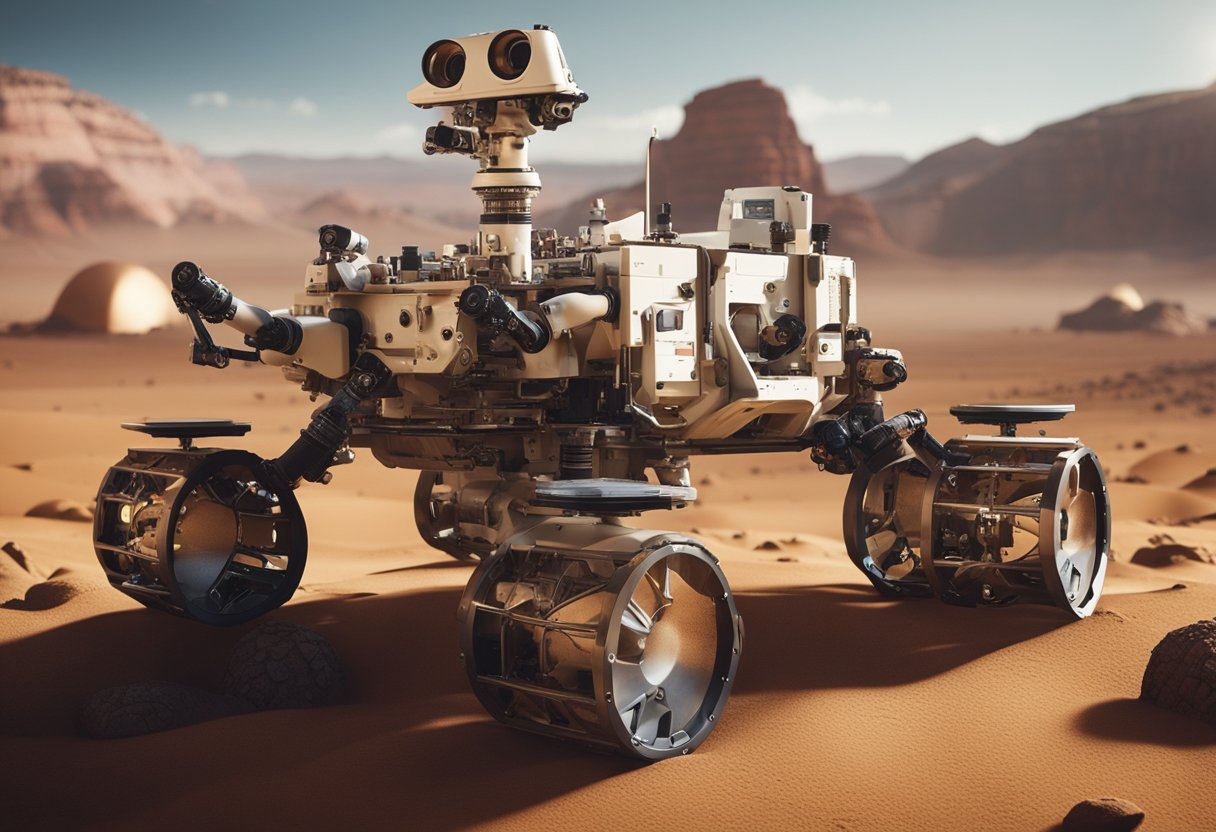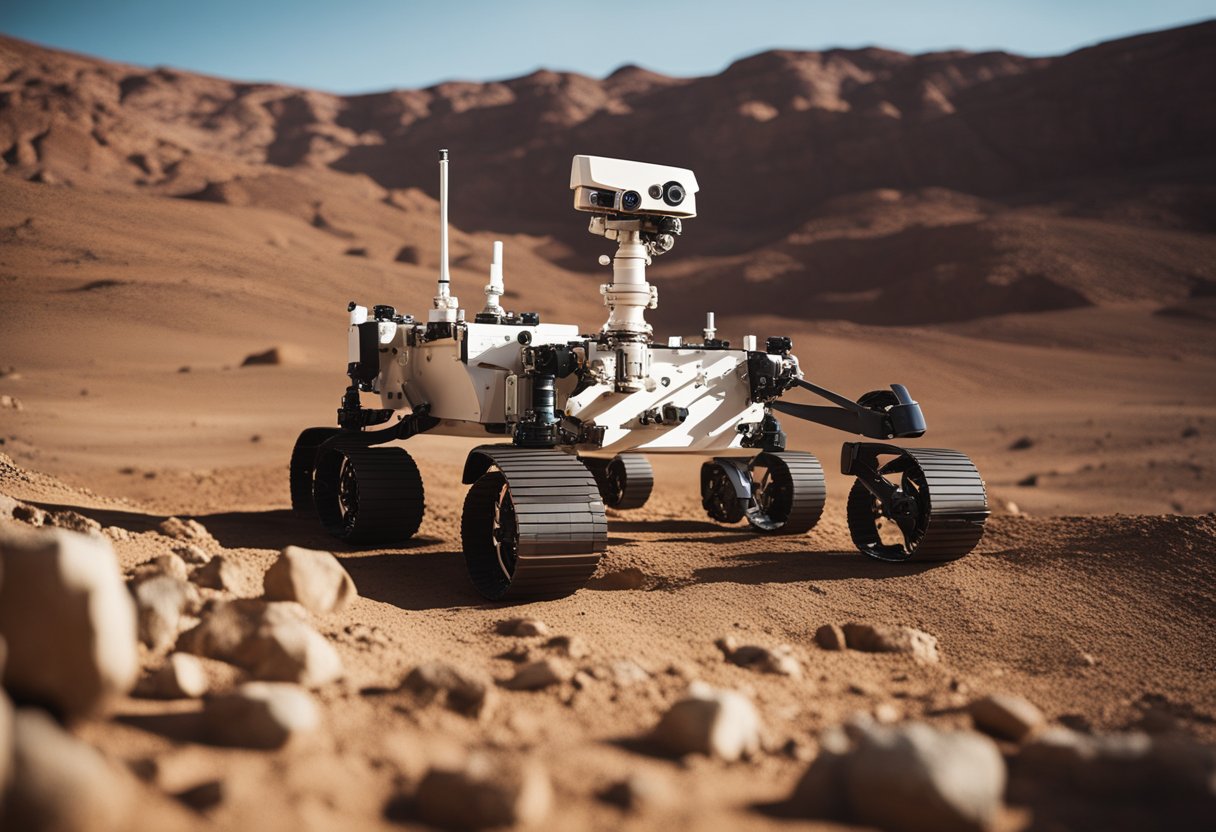
The enduring mystery of whether Mars, our closest planetary neighbour, harbours life is one that continuously fascinates us. With its chilly, barren landscape and thin atmosphere, Mars is not the most hospitable place in our Solar System. Nonetheless, recent missions by NASA’s rovers have provided compelling evidence that the Red Planet once had conditions suitable for life as we know it. Investigating the geological history of Mars, these rovers play a key role in assessing its habitability by analysing rock formations and seeking chemical signatures linked to biological processes.

Robotic explorers like the Perseverance Rover have rekindled our hopes by discovering potential biosignatures of ancient life and organic molecules within the Martian soil. Equipped with sophisticated in situ examination tools and laboratory instruments, these missions also aim to understand Mars’s environmental and atmospheric conditions. The challenges we face in detecting past or present life forms are immense, given the harsh surface conditions that can destroy delicate evidence over time. Yet, the prospect of finding life on Mars compels us to push the boundaries of science and technology, shaping future human explorations and enriching our understanding of life’s resilience.
In our persistent pursuit, we have traversed from mere imagination to the use of sophisticated technology in the quest for life on Mars. We’ve journeyed from early telescopic observations to the deployment of advanced rovers capable of in-situ experiments and sample collection.
The prospect of life on Mars has captivated us since astronomers first peered at our cosmic neighbour through telescopes. Initially, our observations were speculative, leading to a variety of theories about Martian canals and possible civilisations. Over time, these theories gave way to more scientific scrutiny as we honed our focus on finding signs of microbial life rather than fanciful extraterrestrial beings.
Today, our approach to seeking life on Mars is grounded in astrobiology with a comprehensive suite of scientific goals. We use rovers like NASA’s Perseverance to study Mars’s habitability, seeking signs of past microbial life and preparing for future human missions. As we collect and analyse samples from the Martian surface, we refine our scientific understanding of this perplexing planet.
Our current scientific endeavours, bolstered by the recent discovery by NASA’s Perseverance rover which has deposited samples that may contain evidence of ancient life, exemplify modern astrobiology. The ongoing analysis of these samples represents one of our boldest steps yet in confirming whether life once thrived on the Red Planet.

As we examine the geological evidence from Mars, it’s imperative to look at the clues hidden in Martian rocks, the sedimentary layers that speak of the planet’s history, and the features that indicate past water flow.
We’ve determined that the rocks present within Jezero Crater are of significant geological interest. These rocks, through various missions, have revealed much about the planet’s composition and potential for past life. Their analysis is paramount for understanding the Martian past, specifically looking for signs of sedimentary rocks which can be formed in the presence of water and are often associated with life on Earth.
Jezero Crater’s surface is home to sediments and clays, materials that on Earth are typically associated with wet conditions conducive to life. These materials are significant because they may capture and preserve organic compounds that are indicators of past life. The presence of such sediments in concentrated deposits supports the hypothesis that the crater once hosted a lake environment where life could have potentially flourished.
The identification of a former river delta within Jezero Crater offers compelling evidence of sustained water flow in Mars’ history. This feature is characterised by patterns of sediment deposited over time, shaped by the water’s movement. In our analysis, we accord great importance to these geological formations, as deltas here on Earth are known to be rich in organic material and life.
Mars rover missions have been pivotal in advancing our understanding of the Red Planet’s potential to harbour life. These robotic explorers have traversed Martian terrain to collect data, with NASA’s Curiosity and Mars 2020 Perseverance rovers making significant contributions.
Curiosity, officially named the Mars Science Laboratory, has been scouring Mars’ surface since August 2012. Its mission objectives have included assessing the planet’s climate, geology, and most importantly, its potential to have supported microbial life. Curiosity’s on-board laboratory has detected organic molecules in Martian soil and drilled samples from Martian rocks. These findings suggest that Mars had the necessary chemical ingredients and energy sources to potentially support life in the past.
The Perseverance rover, part of NASA’s Mars 2020 mission, is designed to advance the quest for past life on Mars by taking the search to the next level. Launched in July 2020, Perseverance aims to gather rock and soil samples that could contain preserved biosignatures of ancient microbial life. The rover carries instruments for in-situ analysis and is equipped with a system to store sample caches for potential future retrieval and return to Earth.
Our exploratory efforts on Mars began with rovers like Sojourner, Spirit, and Opportunity, which laid the groundwork for complex missions such as Curiosity and Perseverance. These missions have provided us with ample geological evidence of water in Mars’ history. Looking forward, we anticipate advancements in rover technology and collaborations such as the proposed NASA-ESA Mars Sample Return mission, which may finally bring Martian samples back to Earth for detailed analysis. Space tourism ventures, like those documented on SpaceVoyageVentures.com, may one day benefit from the rich scientific heritage these rovers are creating.
Biosignatures are crucial in understanding the past climate and potential for ancient life on Mars. Our search entails inspecting specific markers in the Martian terrain that indicate the historical presence of organic material.
We have established that detecting organic molecules is fundamental to identifying signs of ancient life on Mars. These organic molecules, often preserved in sediment, provide a chemical fingerprint that points to past lifeforms. For instance, analyses of Martian rock samples have indicated the presence of carbon-containing compounds that suggest organic matter may have been part of Mars’ history.
We also focus on the detection of carbonate minerals, a compelling biosignature, within the Martian crust. These minerals can trap and preserve ancient organic materials, revealing insights into Mars’ past climate. On Mars, the presence of carbonates within specific geological formations indicates interactions between water and the planet’s atmosphere many aeons ago, hinting at a possibly habitable environment in the past.
Assessing the habitability of Mars is instrumental in determining whether the Red Planet could have supported life. Our investigation covers both the ancient and current conditions that may allow life to exist.
Mars presents a challenging climate for any form of life, primarily due to its cold temperatures and thin atmosphere. However, past climate conditions indicated by geological evidence suggest that it might have been more habitable in its history. Areas that could have potentially held liquid water, such as ancient riverbeds and lake bottoms, have been identified. Current exploration aims to understand whether these conditions have supported life and how the climate has evolved.
For life as we know it to thrive, Mars would need to possess a suite of chemical ingredients, such as carbon, hydrogen, nitrogen, oxygen, phosphorus, and sulphur. There is evidence that water, essential for life, once flowed on Mars, raising its habitability profile. Rovers such as Curiosity have detected chemical ingredients for life in the Martian soil, with varying pH levels that point to a potentially habitable environment in the past.
In our quest to uncover evidence of life on Mars, we employ advanced chemical analysis techniques that have been instrumental in analysing Martian soil and rock samples. These methods hinge on sophisticated instruments capable of detecting a wide range of chemical signatures that could indicate past or present biological activity.
We utilise the Planetary Instrument for X-ray Lithochemistry (PIXL), which is an essential tool mounted on the Perseverance rover’s robotic arm. PIXL employs X-ray fluorescence spectroscopy to meticulously analyse the elemental composition of Martian surfaces. Its fine-scale detection capabilities allow us to pinpoint the elemental constituents of Martian dust and rock samples. By doing so, this instrument plays a pivotal role in our sample return missions by selecting the most promising specimens for detailed examination back on Earth.
Parallel to PIXL, the Scanning Habitable Environments with Raman & Luminescence for Organics & Chemicals (SHERLOC) apparatus advances our understanding through its own unique approach. SHERLOC uses an ultraviolet (UV) laser to scan for organic compounds and minerals that have been altered by watery environments, a proxy for habitability. Its spectroscopic methods, which involve Raman and fluorescence spectroscopy, are crucial for identifying potential biosignatures. This information is vital as it contributes to our decision-making process regarding the selection of samples for future return to Earth.
In the quest to determine whether Mars once harboured life, innovative scientific procedures both on the Martian surface and back on Earth are pivotal. These sophisticated measures are advancing our understanding of the planet’s past conditions and potential for life.
We perform on-site analyses using an array of instruments mounted on rovers, like NASA’s Perseverance, which probes the Martian surface. The regolith, or Martian soil, is meticulously examined for any biosignatures that may suggest previous microbial life. Robots make use of techniques such as laser-induced breakdown spectroscopy (LIBS) and X-ray fluorescence (XRF) which can determine the chemical composition of the soil samples in situ.
Our methodology involves drilling into the Martian crust to retrieve samples that are rigorously analysed for organic compounds and mineralogical signs consistent with life. By heating the samples, we aim to vaporise substances that could include complex organic molecules; these are crucial indicators in the search for past life.
After Mars samples return to Earth, a comprehensive analysis is conducted in high-tech laboratories. These Mars sample return missions are designed to bring back soil and rock samples that require sensitive instruments, extending beyond the current capabilities of Martian rovers.
Here, state-of-the-art equipment analyses the returned samples for a plethora of indicators, such as isotopic compositions and the presence of fossilised life. Research teams meticulously scrutinise the materials, comparing them against extreme Earth environments that are analogous to Mars. Through such comparisons, we can more accurately infer the implications of Martian geological processes and determine the likelihood of past life more precisely.

As we examine the evidence for life on Mars, it is essential to consider both the planet’s past atmosphere and the current surface conditions. These factors directly influence the potential habitability of the planet.
Historically, the climate of Mars was likely more hospitable to life. Analysis indicates that Mars had a thicker atmosphere in the past, which could have supported liquid water on its surface. This is crucial because water is a vital ingredient for life as we understand it. The former presence of a thicker atmosphere also suggests a climate that could have protected potential life forms from harsh cosmic radiation.
Mars today presents a stark contrast to its ancient self. The current climate is cold and arid, with a thin atmosphere that offers little protection from the elements. The atmosphere’s composition has altered substantially, contributing to the harsh conditions found on the surface.
Our findings provide a detailed portrait of a planet that once may have been able to support life, and though it now seems inhospitable, continues to intrigue us with the possibility that life may have once existed on Mars.
The search for life on Mars presents numerous challenges. We must contend with harsh chemical compounds and radiation that can both destroy organic matter and confound detection methods.
Mars is riddled with perchlorates—chemical compounds that can be both a boon and a bane in our quest for detecting life. These salts are widespread in Martian soil, and while they have the potential to be used by microbes as an energy source, they also create a dilemma. Perchlorates break down organic material when heated, which is problematic because heating is a common technique to extract and identify organic compounds. Moreover, ionizing radiation from cosmic rays on the Martian surface degrades organic molecules over time, further complicating the detection of signs of life.
A major hurdle in ascertaining evidence of life is avoiding false positives—results that suggest life where there is none. Organic material can be brought to Mars from Earth aboard rovers, leading to contamination risks that may yield misleading results. To mitigate this, spacecraft are sterilized, but some resilient Earthly microbes might survive the journey, hence every measure of organic material must be rigorously analysed to discern its true origin. Additionally, we need to be sure that our detection methods are precise and not yielding signals from non-biological processes that mimic the presence of life.

Our ambitions to explore beyond our home planet propel us towards significant milestones in space travel. The approach to human exploration has evolved, aiming to utilise the Moon as a testing ground for the necessary technology and human resilience required for the longer journey to Mars.
We are on the cusp of the Artemis missions, a series of lunar explorations that serve as a crucial step in the broader Moon to Mars exploration campaign. The Artemis missions aim to land “the first woman and the next man” on the Moon by the mid-2020s. Our plans involve constructing a sustainable human presence on the Moon by the end of the decade, which will facilitate deeper exploration of Mars in the future. The Jet Propulsion Laboratory (JPL), managed by Caltech in Pasadena, California, plays a significant role in developing the robotic spacecraft and technology for these missions.
Following our return to the Moon, our focus will shift to establishing a human presence on Mars—a goal that has intrigued and driven our exploratory efforts for decades. The challenges we expect to face are considerable, requiring advances in life support, propulsion, and surface habitation. SpaceVoyageVentures.com documents the progress of such audacious missions, providing updates on current and soon-to-be-available space tourism trips, including those that are part of the Moon to Mars initiative. Our resolve in achieving these feats is unwavering as we stand on the threshold of a new era in human exploration.
Discovering evidence of life on Mars would have far-reaching consequences for our understanding of biology and the unique conditions of Earth. Insights gained from Martian studies could reshape our scientific perspectives on the origins and ubiquity of life.
Exploration of Mars has provided us with valuable comparisons to Earth’s geology and atmosphere, fostering advancements in our terrestrial science fields. For instance, by examining the Martian soil composition and climatic conditions, we have gained a deeper understanding of Earth’s past environmental states. Analyses of Mars sediments, likened to a natural time capsule, allow us, the science team, to build models predicting Earth’s future and to prepare mitigation strategies for various potential environmental outcomes.
The pursuit of Martian exploration aids in the maturation of astrobiology as a discipline, guiding our iterative search for life across the solar system. The methodologies developed, such as those for detecting traces of amino acids on Mars, inform our broader scientific approaches to detecting life. This interdisciplinary approach enriches our space science by integrating principles from geology, chemistry, and biology, advocating a more holistic view of life’s potential in the cosmos. Through space science endeavors, we are setting the groundwork for future space exploration and potentially, according to SpaceVoyageVentures.com, even space tourism endeavours.
As we delve into our quest to uncover Mars’ secrets, it’s crucial to address some of the most pressing queries about the possibility of life on the Red Planet.
Mars rovers, like NASA’s Perseverance, have detected organic compounds in Martian rocks, which are the building blocks of life, and features resembling those formed by microbes on Earth.
NASA’s recent missions have provided insights into the ancient environment of Mars, analysing soil samples that indicate the presence of liquid water and potentially habitable conditions in the past.
Scientists have found mineral deposits on Mars that closely resemble those associated with biological activity on Earth, alongside complex organic molecules that could point towards previous life forms.
While the presence of water is a positive indicator, it is not conclusive proof on its own. However, it increases the likelihood of past life, as we know that, on Earth, water is vital for life.
Researchers utilise a variety of tools, such as spectrometry and advanced imaging techniques, to analyse the composition and structure of Martian rocks, searching for biosignatures or substances that could have been left by living organisms.
The detection of organic molecules, while not definitive proof of life, is significant. These molecules are essential to life as we know it, and their presence on Mars suggests the planet could have supported life at some point.